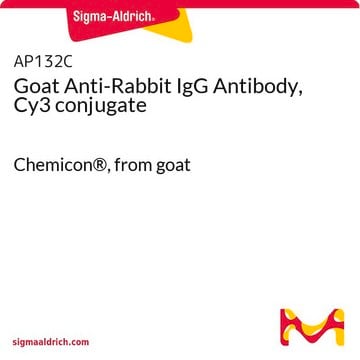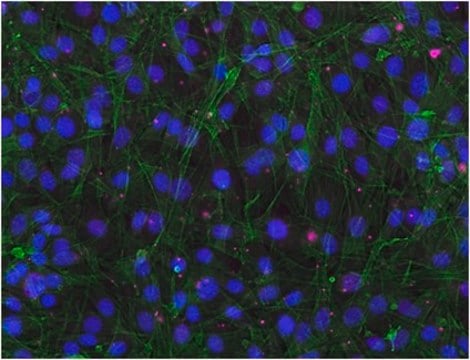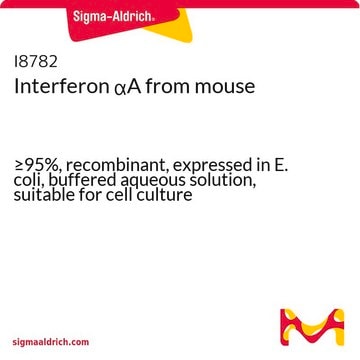AP187C
Goat Anti-Rabbit IgG Antibody, Cy3 conjugate, Species Adsorbed
1.5 mg/mL, Chemicon®
Sign Into View Organizational & Contract Pricing
All Photos(1)
About This Item
UNSPSC Code:
12352203
eCl@ss:
32160702
NACRES:
NA.46
Recommended Products
biological source
goat
Quality Level
conjugate
CY3 conjugate
antibody form
F(ab′)2 fragment of affinity isolated antibody
antibody product type
secondary antibodies
clone
polyclonal
species reactivity
rabbit
manufacturer/tradename
Chemicon®
concentration
1.5 mg/mL
technique(s)
immunofluorescence: suitable
shipped in
wet ice
target post-translational modification
unmodified
Specificity
Rabbit IgG (H+L) (absorbed for minimal cross-reactivity to Human, Mouse and Rat Serum Proteins)
FLUOROPHORE/ PROTEIN ABSORBANCE RATIO
Approximately 2.25-2.8(A552/A280) = 2.7
FLUOROPHORE/ PROTEIN ABSORBANCE RATIO
Approximately 2.25-2.8(A552/A280) = 2.7
Application
Research Category
Secondary & Control Antibodies
Secondary & Control Antibodies
Research Sub Category
Secondary Antibodies Adsorbed for Dual Labeling
Secondary Antibodies Adsorbed for Dual Labeling
Suggested dilution for most applications: 1:100-1:800 for most applications.
Optimal working dilutions must be determined by the end user.
Optimal working dilutions must be determined by the end user.
This Goat anti-Rabbit IgG Antibody, Cy3 conjugate, Species Adsorbed is validated for use in IF for the detection of Rabbit IgG.
Physical form
Lyophilized. Buffer = 0.01 M Sodium Phosphate, 0.25 M NaCl, pH 7.6 with 15 mg/mL BSA, and 0.05 Sodium Azide.
RECONSTITUTION:
Reconstitute to 1.5 mg/mL with sterile distilled water.
RECONSTITUTION:
Reconstitute to 1.5 mg/mL with sterile distilled water.
Storage and Stability
Maintain lyophilized product at 2-8°C for up to 12 months. After reconstitution the product is stable for several weeks at 2-8°C as an undiluted liquid. For extended storage after reconstitution, add an equal volume of glycerol to make a final concentration of 50% glycerol followed by storage at -20°C in undiluted aliquots for up to 12 months. Please note the concentration of protein (and buffer salts) will decrease to one-half of the original after the addition of glycerol. Avoid repeated freeze/thaw cycles.
Legal Information
CHEMICON is a registered trademark of Merck KGaA, Darmstadt, Germany
Disclaimer
Unless otherwise stated in our catalog or other company documentation accompanying the product(s), our products are intended for research use only and are not to be used for any other purpose, which includes but is not limited to, unauthorized commercial uses, in vitro diagnostic uses, ex vivo or in vivo therapeutic uses or any type of consumption or application to humans or animals.
Not finding the right product?
Try our Product Selector Tool.
Hazard Statements
Precautionary Statements
Hazard Classifications
Aquatic Chronic 3
Storage Class Code
11 - Combustible Solids
WGK
WGK 3
Certificates of Analysis (COA)
Search for Certificates of Analysis (COA) by entering the products Lot/Batch Number. Lot and Batch Numbers can be found on a product’s label following the words ‘Lot’ or ‘Batch’.
Already Own This Product?
Find documentation for the products that you have recently purchased in the Document Library.
Kang Chen et al.
Molecular medicine reports, 13(3), 2439-2446 (2016-02-06)
Pseudomonas aeruginosa (PA) is a common Gram‑negative bacterium and can cause serious infections, including hospital‑acquired pneumonia, suppurative bacterial keratitis and acute burn wound infection. The pathogenesis of PA infections is closely associated with excessive inflammatory responses and bacterial virulence factors.
Xufeng Dai et al.
PloS one, 12(11), e0188032-e0188032 (2017-11-14)
Adeno-associated virus (AAV) vectors are important gene delivery tools for the treatment of many recessively inherited retinal diseases. For example, a wild-type (WT) AAV5 vector can deliver a full-length Cnga3 (cyclic nucleotide-gated channel alpha-3) cDNA to target cells of the
Estrogen and androgen receptor expression in surface epithelium and inclusion cyst in the ovary of premenopausal and postmenopausal women.
Mendez, C; Morales-Vasquez, F; Perez-Montiel, D; Gomora, MJ; Espinola-Zetina et al.
Journal of Ovarian Research null
Kayoko Hosaka et al.
Nature communications, 4, 2129-2129 (2013-07-09)
Anti-platelet-derived growth factor (PDGF) drugs are routinely used in front-line therapy for the treatment of various cancers, but the molecular mechanism underlying their dose-dependent impact on vascular remodelling remains poorly understood. Here we show that anti-PDGF drugs significantly inhibit tumour
Yun-Bi Lu et al.
Journal of neurochemistry, 150(6), 723-737 (2019-07-04)
Nicotinamide phosphoribosyltransferase (NAMPT) is the key enzyme of the salvage pathway of nicotinamide adenine dinucleotide synthesis. NAMPT can also be secreted and functions as a cytokine. We have previously shown that in the brain, NAMPT expression and secretion can be
Our team of scientists has experience in all areas of research including Life Science, Material Science, Chemical Synthesis, Chromatography, Analytical and many others.
Contact Technical Service





